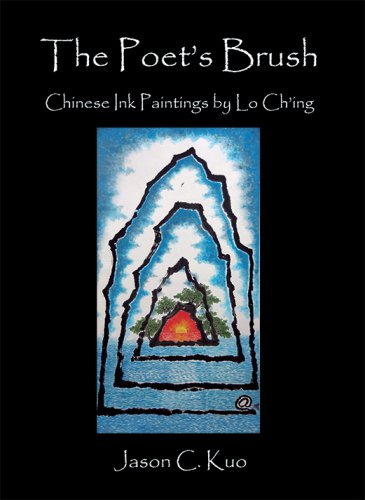
About the Author
Jason C. Kuo is Professor of Art History and Archaeology at the University of Maryland and has taught at the National Taiwan University, Williams College, and Yale University. His numerous publications include: The Austere Landscape: The Paintings of Hung-jen, Transforming Traditions in Modern Chinese Painting: Huang Pin-hung’s Late Work, and The Inner Landscape: The Paintings of Gao Xingjian. He edited the volumes Visual Culture in Shanghai,1850s–1930s; Perspectives on Connoisseurship of Chinese Painting; and Stones from Other Mountains: Chinese Painting Studies in Postwar America.
THE POET’S BRUSH: Chinese Ink Paintings by Lo Ch’ing
Jason C. KuoNew Academia Publishing, 2016
442 Pages, 336 Illustrations
ISBN 978-0-9974962-4-6 Hardcover
For BULK ORDERS, order directly from New Academia Publishing.
Queries: orders@newacademia.com
About the Author
Jason C. Kuo is Professor of Art History and Archaeology at the University of Maryland and has taught at the National Taiwan University, Williams College, and Yale University. His numerous publications include: The Austere Landscape: The Paintings of Hung-jen, Transforming Traditions in Modern Chinese Painting: Huang Pin-hung’s Late Work, and The Inner Landscape: The Paintings of Gao Xingjian. He edited the volumes Visual Culture in Shanghai,1850s–1930s; Perspectives on Connoisseurship of Chinese Painting; and Stones from Other Mountains: Chinese Painting Studies in Postwar America.
About the book
Lo Ch’ing is one of China’s foremost contemporary poet painters. Despite the differences in their circumstances, many contemporary Chinese painters share one common trait: they have been stimulated by contact with contemporary Western art, but they did not merely imitate it; instead, they have rediscovered the abstract and expressionistic possibilities in their own tradition. It is in this sense that they are heirs to the great tradition of Chinese painting. Through their synthesis of the theories, techniques and styles of traditional literati painting in their own work, they were able to achieve innovation that enriched the tradition. These artists exemplify one of the best ways to be contemporary Chinese artists.
Lo Ch’ing has internalized such conflicting state of tradition and modernity (or even post-modernity, if you will) in his work. The “Chinese tradition” takes a not-so-subtle turn in the Taiwanese environment. Indeed, Taiwan was, incidentally, the most curious and embracing place for matters of experimental nature, particularly during late 1970’s to 1980s when Lo Ch’ing rose to fame. The rise of industrialization, post-industrialization, and curious issue of Taiwan’s cultural identity created a nurturing and controversial ground for creative talents. Industrialization and post-industrialization are subjects of Lo Ch’ing’s work. Certainly, there is an oddity in Lo Ch’ing’s depiction of alien saucers and floating rocks and mountains, yet Lo Ch’ing’s work presents a fresh curiosity that had not been explored in the practice of in painting precisely for that reason. Scholars often used the phrase “reinvention of the Chinese landscape” to describe and define Lo Ch’ing’s work and his motivation behind it, and it’s not entirely correct. To put it in correct historical term, however, it was not the artist who industrialized the landscape, not to mention one can easily argue that the urban landscape of Taiwan is one that is drastically different than landscapes in China. Lo Ch’ing’s’work has a heightened sense of awareness in its presentation of any subject in this matter, and that Lo Ch’ing’s work is very conscious of the environment that its content was derived from. Urbanity, interestingly enough, would be an idea that is in opposition to the tradition of Chinese literati landscape painting, for it means the destruction of nature.
Praise
“Throughout the arc of Lo Ch’ing’s diverse creative work in both painting and poetry, one finds a constant sense of play, play of the most serious kind. Lo combines mastery of the media with an ability to push it in the most unexpected directions, leaving his audience with wry, ironic, and intellectually challenging work. This ranges from the graphic pun to the conceptual enigma, from kitty cats to black holes. Brushwork becomes content; content becomes form. This collection of Lo’s paintings and Jason Kuo’s contemplation of them are powerful testament to that poignant playful process.”
—Joseph R. Allen, Professor of Chinese Literature and Cultural Studies, University of Minnesota, Twin Cities; author of Taipei: City of Displacement
“Lo Ch’ing has been a central figure in Chinese literary and art circles since the 1970s, breaking molds in the practice of writing vernacular poetry and in the rather conservative ink-painting traditions of past- and present-day China. Kuo’s book is a major scholarly contribution to his artistic work, which is, if nothing else, consistently and systematically disruptive of overly simple categories of style, genre, and even media, both visual and verbal.”
—Paul Manfredi, Associate Professor of Chinese and Chair of Chinese Studies Program, Pacific Lutheran University; author of Modern Poetry in China: A Visual-Verbal Dynamic





 Coming Soon
Coming Soon Awards
Awards